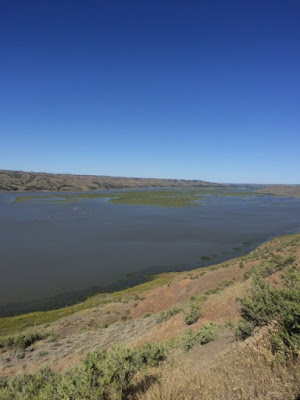The Terms “Rancher” and “Conservationist” are Not Mutually Exclusive
Guest post by Clemson Montana Summer Program student Addie Carter
Ranchers seem to have this stigma around them that they hate
wildlife and don’t want it on their land because they want all the grass to go
to their cattle. I’m learning though during my time here in Montana that
generally that’s not the case. While ranchers do want to have enough grass for
their cattle, many are not opposed to wildlife on their land and in most cases
they’re proud of it. While we were on the Robinson’s Ranch in southern Phillips
County, we talked with the Ranchers Stewardship Alliance about their opinions
on wildlife and ranch management. Like all the other ranchers I have meet on
this trip, they were extremely passionate about their work and their way of
life. We learned about past generations like the Robinson brother’s father who is buried on the land that he invested his entire
life into, and about the new generation like Leo Barthelmess’ son, who he is
very proud to have working on his ranch expanding their sheep herd. This
family-style ranch, where it has been passed down through generations, is why
the ranchers are so invested in and why they want the best for the land.
Surprisingly enough, while talking to the RSA, I learned
that they believe that the best ranch management practices include wildlife. Their
opinion is that if you have healthy wildlife populations on your land, then
that means that your grassland has high biodiversity which in turn gives the
cows better grazing forage. Obviously, there is a limit to how much wildlife
they want on their land so they maintain the numbers through hunting, but
overall they enjoy seeing the wild animals on their land. Now I did think to
myself upon hearing this that they might just be saying this to us to get us to
favor cattle ranching. So where’s the evidence? The evidence happened to be
sitting on top of its burrow on our drive out. Prairie dogs used to be a
nuisance species that were poisoned on sight, so the fact that the Robison had
some on their ranch was, in my opinion, a good indication that they do in fact
have a higher tolerance of wildlife then I previously thought.
Obviously this tolerance of prairie dogs has not been around
forever, as shown by Montana’s good neighbor policy where prairie dogs within a
certain distance from the property line have to be poisoned so they don’t run
over into the neighbor’s property. This old fashion mindset is being changed by
conservation organizations like The Nature Conservancy (TNC). I found TNC’s approach
to wildlife conservation to be very interesting and effective. They offer ranchers
a reduced price to lease their land depending on if certain wildlife species
are on their land, like prairie dogs, or if their fencing is safe for wildlife.
This gives ranchers an incentive to incorporate better wildlife-friendly
practices on their ranch without the ranchers feeling like they are forced into
it. The public opinion of The Nature Conservancy seems to be very positive among
the ranchers, and this relationship between the ranchers and TNC is very
important because it allows for open talks about wildlife, cattle, and the
future of Montana between people who have an understanding of each other and
their background.
I am starting to see that these two terms “rancher” and “conservationist”
are not mutually exclusive. I have learned through my time here that the
ranchers want wildlife on their lands if not because of the aesthetic value
then because of the consequences if wildlife is not there. In 2015, the greater
sage grouse was considered for endangered status. This was a wake up call for
many people in Montana, because having a species being listed as endangered puts
a lot of restrictions on what can be done to it on both private and public
lands. The State of Montana came together to make a plan to prevent the decline
of sage grouse and hopefully stop the need to have them classified as an
endangered species. This unification between the government and the public was
evident when we went to meet with Mark, Lonnie, and John who work on a Sage
Grouse Initiative Project. This initiative studies sage grouse and is
constantly working on ways to evolve the management practices of sage grouse.
Around 85% of their research is conducted on private land, and much of this
land is owned by ranchers with whom they try to maintain a good relationship with because
it is with their support that the sage grouse will be able to achieve a
sustainable population.
Collectively, from these experiences in Montana my opinion
is that the best way for Montana to reach a balance between ranching and wildlife
is through unification of the community. On our last day in Montana, John
Carlson said something that summarizes this: “Conservation is not just changing
management but mind sets as well”. I
think this way of viewing conservation will not just work for wildlife
conservation in Montana, but worldwide.



